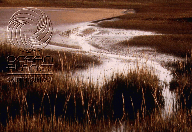The text on this site is presented as an archival version of the script of "Ocean Planet," a 1995 Smithsonian Institution traveling exhibition. The content reflects the state of knowledge at the time of the exhibition, and has not been updated.
 Sand crabs in salt marsh, Sapelo Island, Georgia,1989
Sand crabs in salt marsh, Sapelo Island, Georgia,1989
The information on this buoy is divided into the three categories listed below.
![]()
There's more to swamps and marshes than meets the eye. Awash with nutrients and plant debris, coastal wetlands are prime nurseries for fishes, shrimps, and crabs, and nesting sites for waterfowl §. Not only do wetlands crawl with wildlife, they also filter out pollutants, buffer inland areas from storm, wave, and flood damage, and support food production for humans §.
 Red and black mangroves, Belize
Red and black mangroves, Belize
Thickets of mangrove roots are perfect nurseries for wild shrimp and fishes. An added bonus, the roots protect coasts from wind and wave erosion §. Most tropical countries have lost more than half of their mangrove forests to logging, urban development, or conversion to rice fields, cropland, or fish-farming ponds §.
photo © Tony Rath
You can search the TIME Magazine Archives for latest news stories on:
![]()
Few wetlands demonstrate dilemmas of development more starkly than Florida's Everglades. Since 1920, drainage to create farmland or housing has dried out half of the Everglades National Park, and left the rest heavily polluted §.
The Everglades' sawgrass fields, dry pinelands, "islands" of trees, and mangrove forests once supported over 600 kinds of animals and 900 of plants. In the past 50 years, pollution or water-flow disruption and complete drainage in some areas have disturbed or destroyed many habitats. Wild populations, especially of birds, have plummeted; the number of wading birds that nest in the national park has dropped by more than 90 percent. §
photo © Jeff Widener/Silver Image
You can search the TIME Magazine Archives for latest news stories on:
![]()
Over half of America's coastal wetlands border the Gulf of Mexico §. Louisiana has been hard hit by wetland loss from rising sea level, land settling due to ground-water use, levees on the Mississippi River, and dams on its tributaries, as well as channels dredged through wetlands §. To slow a rate of loss as high as 32 square miles per year §, the state has established a Wetlands Conservation and Restoration Fund that supports coastal wetland restoration projects. §
 Planting projects play a major role in saving Louisiana's
coastline
Planting projects play a major role in saving Louisiana's
coastline
Vegetation helps hold the mud together and prevents it from washing away. Smooth cordgrass, a salt-tolerant plant, is widely used. §
photo © Louisiana Department of Natural Resources
![]() Ocean Planet Exhibition Floorplan
Ocean Planet Exhibition Floorplan
![]()